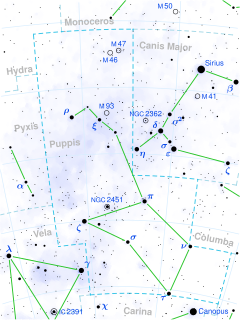WD 0810–353
White dwarf star in the constellation Puppis From Wikipedia, the free encyclopedia
WD 0810-353 (UPM J0812-3529) is a white dwarf currently located 36 light-years (11 parsecs) from the Solar System. This stellar remnant may approach the Solar System 29,000 years from now at a distance of around 0.15 parsecs, 0.49 light-years or 31,000 AU from the Sun, crossing well within the proposed boundaries of the Oort cloud.[3] Such close proximity will almost certainly make its flyby the closest in the future, until the flyby of Gliese 710 occurs around 1.14 million years after the dwarf's flyby.
| Observation data Epoch J2000.0[1] Equinox J2000.0[1] | |
|---|---|
| Constellation | Puppis |
| Right ascension | 08h 12m 27.06600s[4] |
| Declination | −35° 29′ 43.3241″[4] |
| Apparent magnitude (V) | 14.469[5] |
| Characteristics | |
| Evolutionary stage | white dwarf |
| Spectral type | DAH[2] |
| Astrometry | |
| Radial velocity (Rv) | −373.74±8.18[4] km/s |
| Proper motion (μ) | RA: −365.479[4] mas/yr Dec.: −329.204[4] mas/yr |
| Parallax (π) | 89.5064±0.0155 mas[4] |
| Distance | 36.439 ± 0.006 ly (11.172 ± 0.002 pc) |
| Details | |
| Mass | 0.63[2] M☉ |
| Radius | 0.01[6] R☉ |
| Luminosity | 0.00017[7] L☉ |
| Surface gravity (log g) | 8.09[2] cgs |
| Temperature | 6,093[2] K |
| Age | 2.7[2][a] Gyr |
| Other designations | |
| UPM J0812-3529, GJ 11192, WD 0810-353, TIC 145863747, 2MASS J08122707-3529433[1][8] | |
| Database references | |
| SIMBAD | data |
Observations
WD 0810-353 is a dim object with an apparent magnitude of 14.5[2] in the southern constellation of Puppis. Its motion perpendicular to the line of sight is considerable; it is consistently listed as a high proper motion star.[9]
Physical properties
WD 1810-353 is a white dwarf of spectral type DAH[2] with a very strong magnetic field, perhaps as strong as 30 MG.[2] It has a mass of 0.63 M☉ and an age of 2.7 billion years;[2] its effective temperature is 6,093 K[2] or 6,273 K[10]. Gaia Data Release 3 (Gaia DR3) gives a value of its radial velocity of −373.74±8.18 km/s which could be incorrect because the Gaia software pipeline does not include any template for white dwarfs.[11] Alternate analyses suggest a radial velocity as high as −4,248 km/s.[12]
Flyby

Considering the values from Gaia DR3, WD 1810-353 will traverse the Oort cloud, disturbing the population of comets there, Given its mass such an encounter like Gliese 710, would not cause a non-negligible orbital change to the Pluto system and Neptune resonant object.[3] Both the minimum approach distance and the timing of this flyby depend strongly on the value of the radial velocity.[11] The Gaia DR3 mean BP/RP low-resolution spectrum suggests that WD 0810-353 could be a hypervelocity runaway white dwarf ejected during a type Ia supernova explosion.[12] Extensive analyses show that the relative velocity during the flyby could be high enough, or the minimum approach distance large enough, to prevent any significant perturbation on the Oort cloud.
Very strong and complex magnetic field
New observational data confirmed the very strong magnetic field of this white dwarf and provided a new value of the radial velocity,+83±140 km/s[13]. With this value, the future flyby to the Solar System is unremarkable.[12][13]
Notes
References
Wikiwand - on
Seamless Wikipedia browsing. On steroids.

